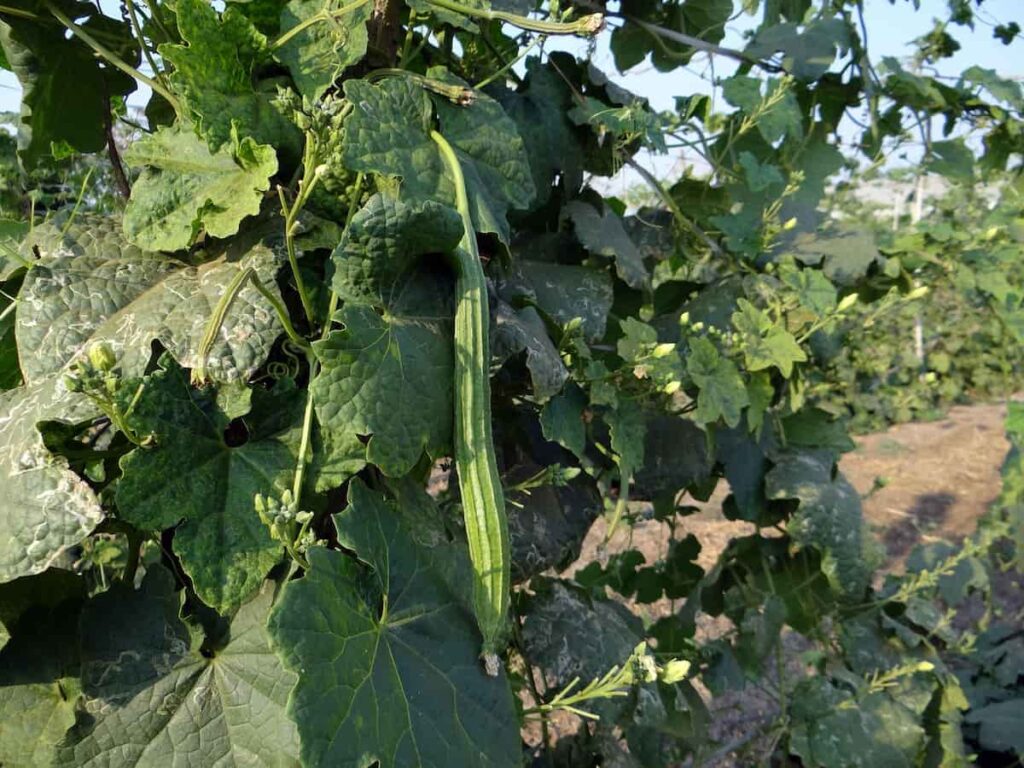Hi friends, today we will explore a success story of a vegetable farmer in India who is making 9 lakh rupees from his Ridge Gourd farm. Along with this success story, we also explain a few questions and answers that arise in your mind while starting a commercial Ridge Gourd farm.
How this farmer earning 9 lakh rupees from his ridge gourd
Which is the best season to grow ridge gourd?
Since ridge gourd needs a temperature of 25 to 35°C for the germination of seeds, it can only be planted during the summer and rainy seasons in locations where the temperature stays over 25°C. It thrives in the warm and humid conditions typical of the tropics. Even though ridge gourd can be cultivated in any soil, the optimal conditions for doing so are loam, clay loam, and silt soil.
The benefits of good drainage cannot be overstated. Both the dry and wet seasons are ideal for growing ridge gourd. Watering the summer crop immediately after planting is essential, and following waterings should be spaced out every four to five days. Crops grown during the wetter months should get no watering.
How many days does a ridge gourd take to grow?
From the time you plant your transplants until you pick your crop is between 60 and 75 days. If you examine the stem immediately adjacent to the gourd, you can determine whether or not the ridge gourd is ready to be picked. If the gourd has begun to shrivel, turn brown, and dry out, it is ready to be picked. Even if the gourd is still green, its stem has dried out, meaning it no longer receives nutrients from the vine.
Does the ridge gourd need full sun?
Like other cucurbits, ridge gourd needs 6-8 hours of daily sunshine. When a plant doesn’t receive enough light, its development is inhibited. If the top inch of soil on your plant’s pot becomes dry during the summer, it must be watered daily. You shouldn’t water your plants in the afternoon or with water straight from the water heater. Male and female blooms of the ridge gourd appear on different parts of the same plant. The wind or pollinators like bees and butterflies usually do the work of pollination in the wild.
You can, nevertheless, attempt manual pollination to produce fruit if you see blossom loss. Remove all the petals from a healthy male flower, then gently rub the stamen end of the flower’s male component against the female flower’s stigma. It is possible to pollinate three to four female flowers with only one male bloom. Flowers should appear on the plant at about day 60–65 after seeding. Fruit production occurs after pollination, and harvesting ranges from 8 to 12 days.
Is ridge gourd self-pollinated?
The ridge gourd develops male and female blooms distinct from one another. While male flowers do not have any kind of fruit connected to them, female flowers always have. The fruit is always attached to the bottom of the female blooms. Bees are responsible for much of the process of pollination. You must pollinate the flowers yourself if you do not have any bees in your garden.
How do you increase the yield of ridge gourd?
It is recommended that the soil, or main field, be adequately prepared by four to five ploughings, and a pH range of 6.5 to 7.5 is suitable for the growth of Ridge gourd. This vegetable crop needs adequate drainage to thrive. Adding organic matter or farmyard manure might anticipate better production and an improved quality of food (FMY).
In case you missed it: A Guide to Understand Guava Plant/Tree Propagation: Check How this Guide Helps Guava Farmers
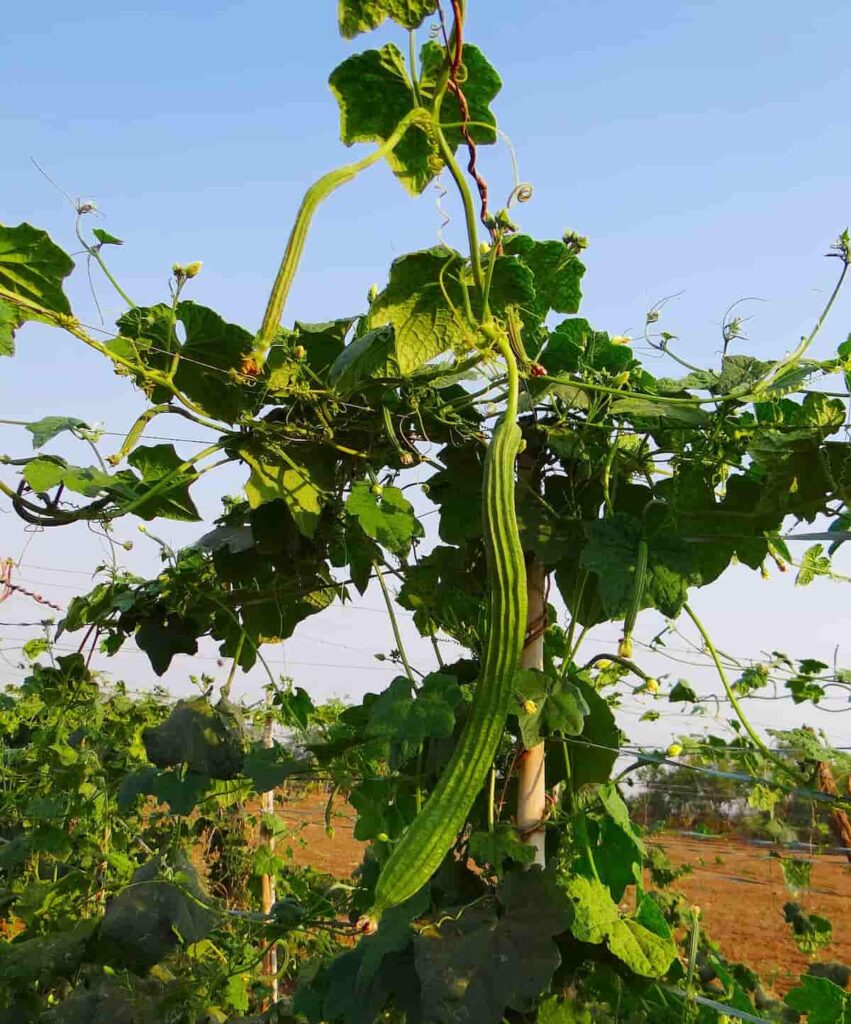
How do you control viruses in ridge gourd?
The sucking insect pests are responsible for the spread of this mosaic virus. Once the plant has been infected with mosaic viral diseases, there is no way to treat it. Spraying this crop with systemic insecticides regularly will help stop the spread of the virus that causes the sucking pests.
How do you increase the yield of Ridge gourd?
It is recommended that the soil, or main field, be adequately prepared by four to five ploughings, and a pH range of 6.5 to 7.5 is suitable for the growth of Ridge gourd. This vegetable crop needs adequate drainage to thrive. By adding organic matter or green manure, one might anticipate better production and an improved quality of food (FMY).
Why are my ridge gourd leaves turning yellow?
Deficiencies in one or more nutrients are probably what’s causing the symptom. Nitrogen shortage often manifests in the veins of a leaf, becoming yellow but can spread to the whole leaf in older plants. On the other hand, a potassium deficit might make the leaves yellow at the margins (mostly in older plants).
The plants require potassium if they are frail and easily broken. Dull leaves signify that nitrogen is needed (leaves get dull before they are yellow, not after). Nitrogen-rich plants have glossy, or at least more glossy, leaves. Potassium-rich plants are far more resistant to damage and have less flexibility. Each nutrient may play a role in plant growth, but your plants may require both.
The success story of Mr. Prakasham
Compared to high-investment and long-run cultivation crops, crops with less investment with short growing seasons have large scopes for profit, says Mr. Prakahsam. Mr. Prakasam is a farmer from Mahbubnagar district, Telangana, who started ridge gourd farming seven years ago. Before starting this successful agriculture venture, he used to cultivate paddy. From his experience, he says that long-run crops involve high investment and larger risks.
Also, considering the unpredictable rainfalls and other climatic conditions, he almost lost all his savings and faced huge losses from paddy cultivation. Keeping in mind his financial situation, he then started ridge gourd farming which involves less investment, less water, and a shorter growth period.
He soon learned that ridge gourd farming has a huge scope, higher profits, and fewer risks. By starting this venture, he was so successful that he expanded and earned huge respect from his villagers. Now let us check into the details of Mr. Prakasham’s ridge gourd and learn about his experiences and success in his own words.
In case you missed it: How This Farmer Earned 5 Lakhs from Fish and Prawn Mixed Farming: A Success Story of an Aqua Farmer in India
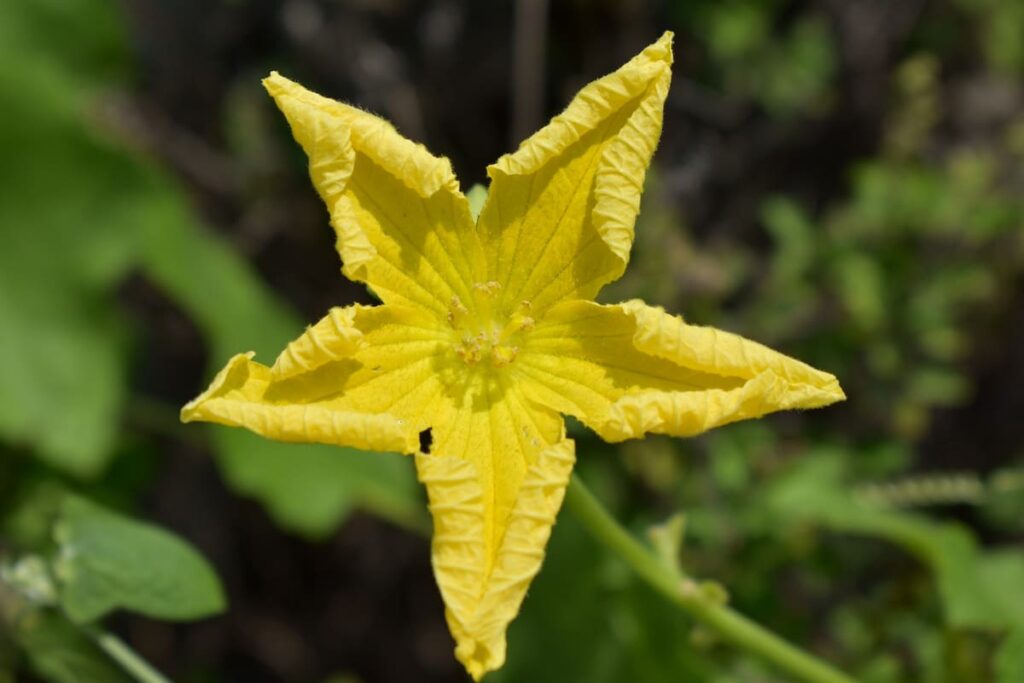
Pergola construction details of Mr. Prakasham’s farm
Ridge is a vine variety that can be cultivated directly on the ground. This type of cultivation has many disadvantages, and fruit quality is not great. To prevent this, he chose the pergola ridge gourd cultivation. This type of ridge gourd cultivation involves a pergola for the whole farm. This is an essential one-time investment, says Mr. Prakasham. A pergola aids ridge gourd vegetables’ easy development and growth and helps the vines creep smoothly. The developed vegetables will be hanging from the pergola, which, when matured, will be harvested.
In this process, harvesting can also be done very easily. Once we construct a pergola, it can last up to 20 years, says Mr. Prakasam. He constructed a pergola on his 4-acre farm for ridge gourd cultivation. Normally for the construction of a pergola, it would take nearly 2-2.5 lakhs per acre, but it cost Mr. Prakasham only 1.1 lakh per acre, totaling 4.4 lakhs for 4 acres. How did he do this? Most people don’t know that there will be subsidies given to pergola construction.
Before starting this venture, he thoroughly investigated every minute detail and found a 50% subsidy. Taking advantage of government support, he could finish the pergola construction in just 4.4 lakhs for his farm. It takes nearly 200 poles for pergola construction per acre. Between each pole, there must be 15 feet distance. Most people use stone poles as they are cheap, but they can easily break while plowing the field. To avoid this, Mr. Prakasam used cement poles.
In a pergola for vines to creep, there must be some wires as a covering upside, with some particular distance between them. He selected 10mm GI (galvanized iron) wires from Tata company, as they won’t rust and will have a long life. Mr. Prakasham says that the wires shouldn’t be thin, as there is a higher chance of breaking in the long run. These minute details are very important, says Mr. Prakasham from his experience.
Land preparation details, according to Mr. Prakasham
For land preparation before cultivation, Mr. Praksham used nearly 2-3 tractors of cow manure, potash, 2 kg of Boron, 50kgs of Neem Flour per acre. He created rows that were 15 feet apart. Seven feet distance is ideal, but as conditions were not ideal for plowing when he started, he created a 15 feet distance between the rows.
He followed the paired row procedure to cover the yield: plant seeds side by side along each row. Also, mulching covers play a vital role in ridge gourd cultivation. Mulching covers should be installed once the land cultivation is finished and rows are made. Mulching covers prevent any extra vegetation in the rows, reducing the weeds.
In case you missed it: How this Farmer Earning 40 Lakhs from His Cucumber Farm: a Success Story of a Polyhouse Farmer in India
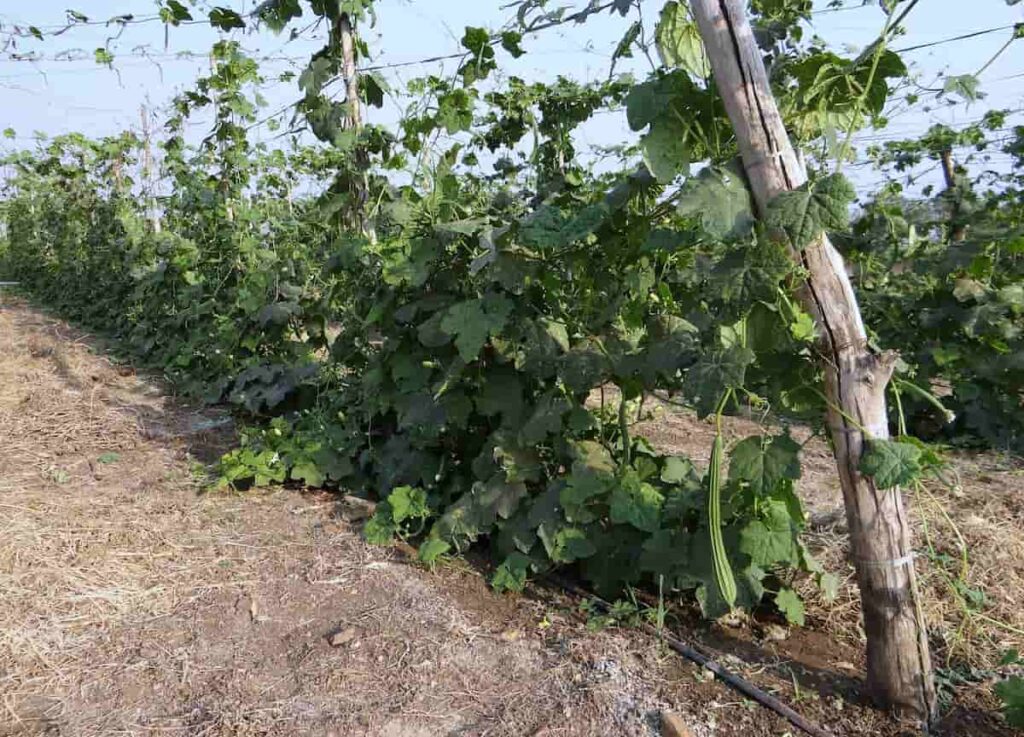
Ridge gourd cultivation details in Mr. Prakasham’s words
Mr. Prakasham planted 1 kg of seeds per acre on his farm. One seed packet weighs nearly 50 grams, and he used nearly 20 packets. Also, Mr. Prakasham chose hybrid variety seeds as they are in high demand in the market. Between each plant, there is a 2 feet distance. By following this 2 feet distance method, he could stock nearly 5000 to 5200 seeds per acre, says Mr. Prakasham. Watering is done by drip irrigation method. This is the ideal method for watering vine plants, according to Mr. Praksahm.
Once the seeds are planted, 3 to 4 hours of watering is done on the day seeds are planted, and the seeds germinate between 6 to 8 days. After germination, the watering is done once a week. Once the leaves started to emerge from the seeds, he started using WDC waste decomposer every week, and this was done through drip lines and was also sprayed sometimes. He shared a very important point that for the successful growth of any plant, fertilization through drip should be done after the watering is done.
This prevents nutrients from going to a depth out of reach from roots. So the fertigation should be done in the last ten minutes of drip watering. This ensures that the nutrients reach the roots of the plants. Boron helps develop more female flowers, which helps in pollination and high fruit yield. You should spray boron once the flowers start from the vines and can also pass it through drip lines, says Mr. Praksaham.
In case you missed it: How this Farmer Earning 35 Lakhs from His Capsicum Farm: A Success Story of a Bell Pepper Polyhouse Farmer in India
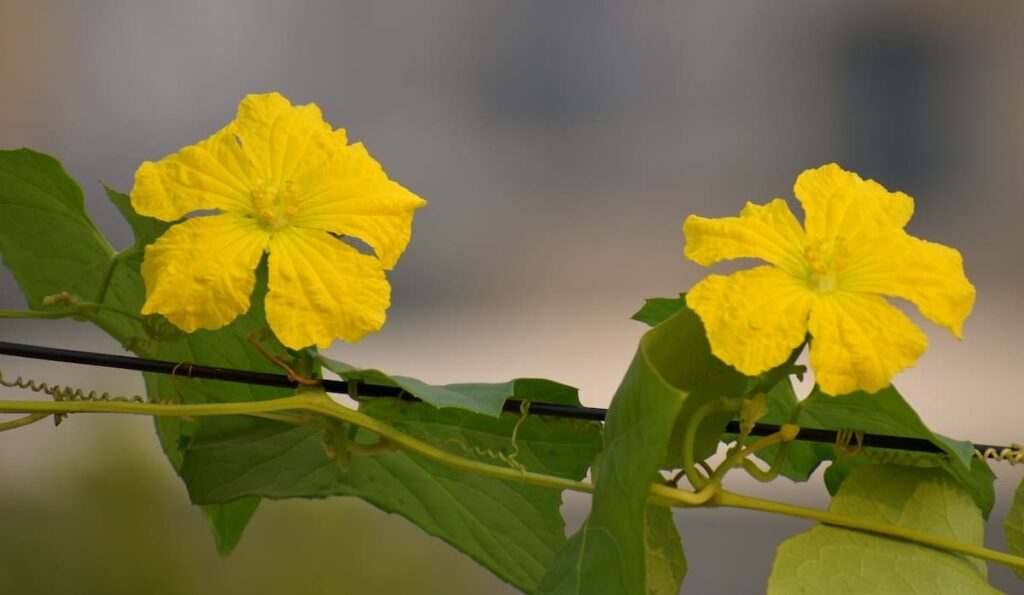
Once the plant reaches 3 to 4 feet tall, it must be trellised to the GI wire with the help of plastic threads. This can help ridge gourd vines creep fast to the pergola. Also, at the stage of initial creeping, the plants develop small horns at the sides, which must be removed. If not, it can make vines harder to creep because of the weight. It can take nearly 15 kgs of plastic thread per acre for trellises.
Pergola ridge gourd cultivation makes it easy for farmers to spray fertilizers or insecticides and also makes it easy to harvest vegetables. The end vegetables from this type of cultivation are long and healthy, making them sell for a higher price in the market. You can get nearly 18 to 24 inches of vegetables from pergola-type cultivation. Also, this cultivation takes less labor as it doesn’t involve much effort, cutting your labor costs.
Detailed fertigation details, according to Mr. Praksham
When and which fertilizer to provide plants is crucial in fertilization. 10 to 12 days after the seed is owned, 12:61:00 water-soluble fertilizer should be used. This has to be given every three days, at 3 kg per acre, through a drip. At the time of flowering, 19:19:19, fertilizer should be used every three days at the rate of 2 to 3 kgs per acre. You have to continue this for 40 days.
Afterward, at 13:00:45, fertilizer should be given at the same rate every three days. This fertilizer helps in lengthening the ridge gourd fruit and its quality development. In between, to manage any deficiencies, he provided calcium nitrate in necessary proportions and boron to improve pollination.
Insect and pest control, according to Mr. Prakasham
To prevent whiteflies and leaf hoppers, yellow and blue sticky boards are used. This can help you reduce pest infestations and calculate what amount of insecticides should be used to control the infestation. There are separate trap baskets in the market to control fruit flies and insects. He used nearly 10 of these trap baskets per acre. This only estimates what amount of insecticide should be used on the crop.
Profit analysis of Mr. Prakasham’s ridge gourd farm
Mr. Prakasham’s ridge gourds sell for nearly 30 to 35 rupees per kg, double the rate of on-ground grown ridge gourd variety. He gets nearly 10 to 12 tons yield per acre. Assuming minimum selling and yield conditions, if his harvest was 10 tons per year and his selling price was 30 rupees, his income would be anywhere near 3,00,000 rupees per acre, which makes 12 lakhs per acre.
In case you missed it: How this Farmer Earning 18 Lakhs from His Strawberry Farm: A Success Story of a Fruit Farmer in India
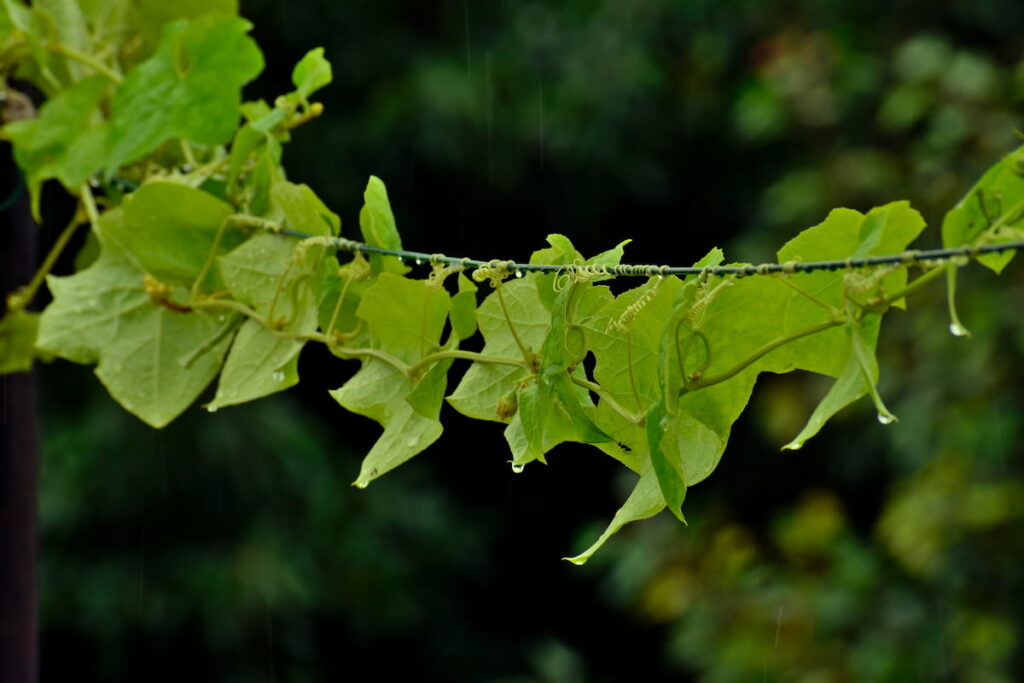
Now coming to his investment, Mr. Prakasham said it took him nearly 80,000 rupees per acre as an investment for everything, which makes 3,20,000 rupees for his four-acre ridge gourd farm. If we eliminate his investment from his income, Mr. Prakasham makes nearly 8,80,000 rupees from his ridge gourd farm as a profit. This is huge. Mr. Prakasham is now a successful ridge gourd farmer and is guiding many farmers in his village toward this pergola ridge gourd cultivation. He is now financially stable and a reputable farmer in his village.
- Types of Pesticides Used in Agriculture: A Beginner’s Guide
- Economical Aquaculture: A Guide to Low-Budget Fish Farming
- 15 Common Planting Errors That Can Doom Your Fruit Trees
- How to Make Houseplants Bushy: Effective Tips and Ideas
- Innovative Strategies for Boosting Coconut Pollination and Yield
- Pollination Strategies for Maximum Pumpkin Yield
- The Complete Guide to Chicken Fattening: Strategies for Maximum Growth
- Natural Solutions for Tulip Problems: 100% Effective Remedies for Leaf and Bulb-Related Issues
- Revolutionizing Citrus Preservation: Towards a Healthier, Greener Future
- Natural Solutions for Peony Leaf and Flower Problems: 100% Effective Remedies
- Maximizing Profits with Avocado Contract Farming in India: A Comprehensive Guide
- Natural Solutions for Hydrangea Problems: 100% Effective Remedies for Leaf and Flowers
- The Ultimate Guide to Choosing the Perfect Foliage Friend: Bringing Life Indoors
- From Sunlight to Sustainability: 15 Ways to Use Solar Technology in Agriculture
- The Ultimate Guide to Dong Tao Chicken: Exploring from History to Raising
- The Eco-Friendly Makeover: How to Convert Your Unused Swimming Pool into a Fish Pond
- Mastering the Art of Delaware Chicken Farming: Essentials for Healthy Backyard Flocks
- 20 Best Homemade Fertilizers for Money Plant: DIY Recipes and Application Methods
- How to Craft a Comprehensive Free-Range Chicken Farming Business Plan
- Brighten Your Flock: Raising Easter Egger Chickens for Beauty and Bounty
- How to Optimize Your Poultry Egg Farm Business Plan with These Strategies
- Subsidy for Spirulina Cultivation: How Indian Government Schemes Encouraging Spirulina Farmers
- Ultimate Guide to Raising Dominique Chickens: Breeding, Feeding, Egg-Production, and Care
- Mastering the Art of Raising Jersey Giant Chickens: Care, Feeding, and More
- Ultimate Guide to Raising Legbar Chickens: Breeding, Farming Practices, Diet, Egg-Production
- How to Raise Welsummer Chickens: A Comprehensive Guide for Beginners
- How to Protect Indoor Plants in Winter: A Comprehensive Guide
- Ultimate Guide to Grow Bag Gardening: Tips, Tricks, and Planting Ideas for Urban Gardeners
- Guide to Lotus Cultivation: How to Propagate, Plant, Grow, Care, Cost, and Profit
- Agriculture Drone Subsidy Scheme: Government Kisan Subsidy, License, and How to Apply Online
- Ultimate Guide to Raising Araucana Chickens: Breed Profile, Farming Economics, Diet, and Care
- Bringing Hydroponics to Classroom: Importance, Benefits of Learning for School Students
- Ultimate Guide to Raising Polish Chickens: Breed Profile, Farming Economics, Diet, and Care
- Ultimate Guide to Raising Australorp Chickens: Profile, Farming Economics, Egg Production, Diet, and Care
- Silkie Chicken Farming: Raising Practices, Varieties, Egg Production, Diet, and Care
- Sussex Chicken Farming: Raising Practices, Varieties, Egg Production, Diet and Care
